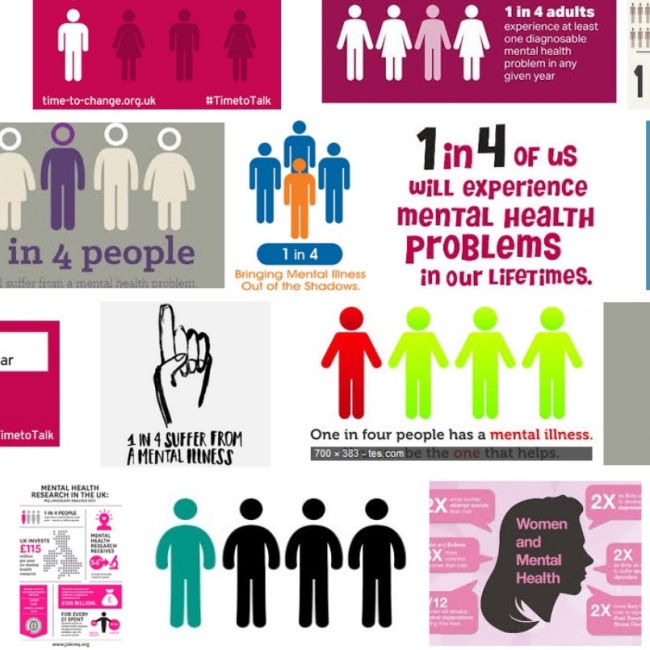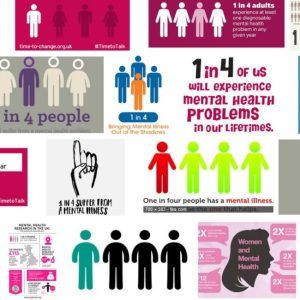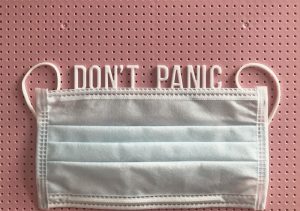
This blog has been written for the Resilience and Wellbeing Network by Dr Jacqui Wilmshurst, chartered psychologist, OH expert and member of the network’s editorial group.
I have witnessed this figure being absorbed with earnest nods and grave faces many times, whilst people contemplate how to help these poor souls with mental illnesses. The snowballing use of this statistic, whilst undoubtedly well-intentioned, can instead end up strengthening the very stigma it seeks to reduce.
When I stand up in front of a room of people and ask them, ‘Did you know that 1 in 4 adults will experience some kind of physical health “issue” in any given year?’ they are quick to tell me how silly that is. Who doesn’t stub a toe, cut a finger, catch a cold or get a nasty headache? We usually manage these health problems and injuries pretty well ourselves, and only seek professional help when we need something beyond our own resources; a course of antibiotics, a stitch for a deep cut, or to check that a bout of headaches isn’t a symptom of something more sinister. We all know that our health is a fluid thing and that we will inevitably have ‘issues’ with it in the course of our busy lives.
So within just a few minutes, the conclusion is usually reached that it is not 1 in 4 of us, it is all of us. There isn’t an ‘us’ and ‘them’; those who are ‘well’ and those who are ‘ill’.
So where does this 1 in 4 statistics come from and how can we move beyond it?
The figure comes from a study in 2007 carried out on behalf of the NHS1 that sought to establish the incidence of psychiatric disorder in people over the age of 16 in the UK. There are a number of issues with the study design, in terms of how the statistic has been used since, and this highlights the danger of using statistics out of context and brings to mind the famous quote (attributed to Mark Twain, but its actual origin remains unknown) that there are three types of lies; ‘lies, damned lies and statistics’2. There isn’t enough time to present a full critique here of both the study and its use, but an illustrative example is that having been conducted during a single year, it is now being reported that it tells us what the figure will be in any given year.
Its use since has been largely to encourage something known as ‘parity of esteem’ with physical health, to encourage greater investment and support for psychological health problems. It was supposed to draw parallels with physical illnesses like cancer (the 1 in 3 statistic was used in cancer awareness campaigns for a long time), but comparisons are limited.
When I deliver mental health awareness sessions, I have yet to find a group who do not agree that viewing mental health as ‘them and us’ is less useful (if not harmful) than framing it as ‘all of us’. If we do that, then it becomes a human issue with some medical aspects, rather than the other way round.
Mental health awareness and mental illnesses
Then some people say, ‘What about the actual mental illnesses, not just the ups and downs of life?’ I encourage people to look at the evidence for ‘mental illness’ as biological diseases (the medical model) and to compare it with the growing body of research on how life events, interacting with our own personalities and learning, will shape how we respond to the world as much as our genetic make-up (the psychosocial model)3. At the very least, most psychologists will now follow the ‘biopsychosocial model’. There is no blood test for schizophrenia and no brain scan for depression. The ‘chemical imbalance’ theory for depression has been debunked time and time again. In times of extreme stress or distress, or after traumatic experiences (whether immediately or sometime later), some will find their sense of reality or of themselves distorted, some will hear voices, some will find that habits become rituals, which can become compulsive and sometimes completely debilitating. All of these reactions have been grouped and given labels, such as schizophrenia or obsessive-compulsive disorder, and these labels can help people to access support, but they should not be defining or bring about judgement.
Just because our biology can and will change at the same time as our moods, our emotions and our thoughts doesn’t mean those biological changes are the cause of our thoughts and feelings. Correlation is not the same as causation. Yet the majority of emphasis (and spending) in mental health is still on the idea of medical diseases and ‘chemical imbalances’ rather than on life experiences, unmet needs and trauma.
This also doesn’t mean that biology isn’t an important factor in our psychological health, nor that medication can’t be helpful. I will take paracetamol for a headache, but that doesn’t mean I believe that my headaches are caused by a lack of paracetamol in my brain. (It’s usually too much wine.)
For this reason, the field of clinical psychology is now moving away from diagnosis based on medical ‘symptoms’ and towards ‘formulations’ that are developed collaboratively to address the list of problems for which the individual is seeking help.
Find out more about the implications of this next time when Jacqui writes about what this means when we want to address mental health issues in the workplace.
- https://digital.nhs.uk/catalogue/PUB02931
- https://en.wikipedia.org/wiki/Lies,_damned_lies,_and_statistics
- https://www.futurelearn.com/courses/mental-health-and-well-being
For more about our Employee Wellbeing courses, or contact us for more information.











